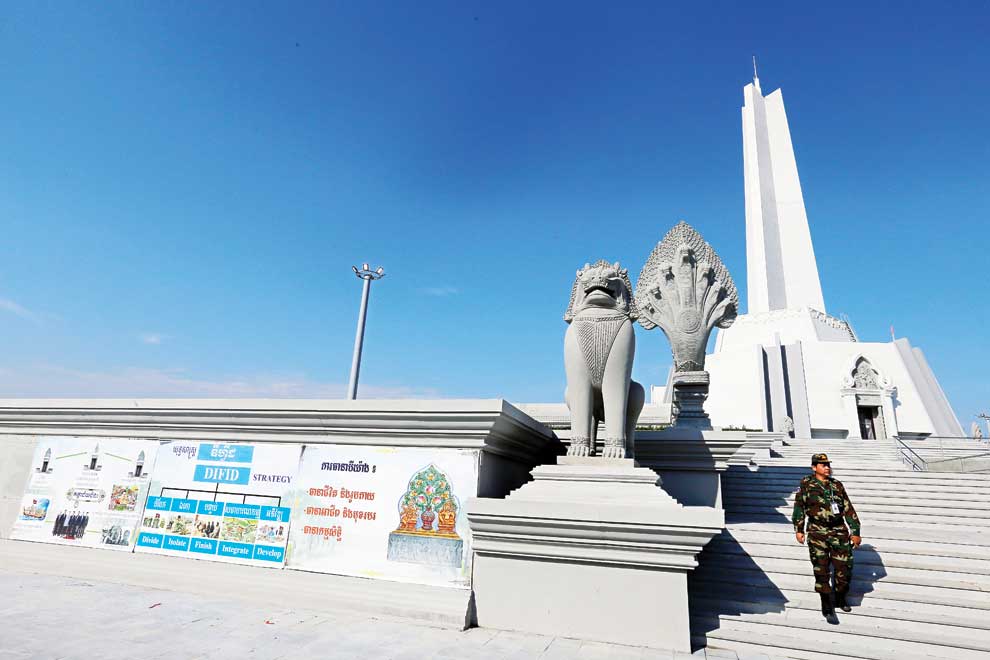
A military officer walks down the Win-Win Monument steps. Heng Chivoan
With the three-day inauguration ceremony of the capital’s “Win-Win Monument” less than 48 hours away, a former Khmer Rouge cadre has described the 1998 policy of Prime Minister Hun Sen it commemorates as “a great achievement for all Cambodians”.
Hun Sen’s “Win-Win Policy” allowed Khmer Rouge holdouts to keep their military positions in exchange for defecting to government forces, ending decades of civil war.
Chhang Youk, executive director of the Documentation Centre of Cambodia (DC-Cam), which catalogues the ultra-Maoist regime’s atrocities, hailed the “Win-Win” policy of 20 years ago as “a legacy of peace”.
The Win-Win Monument sits on an 8ha square in front of the Morodok Decho National Sports Complex being built for the 2023 Southeast Asian Games in Chroy Changvar district’s Bak Kheng commune.
Construction on the 54-metre high memorial began in February 2016.
Its base is a pentagon, representing the five strategic points Hun Sen dubbed “DIFID”, which stands for “Divide, Isolate, Finish, Integrate and Development”. The upper part is a 33-metre high triangular monolith representing the three guarantees made to the Khmer Rouge – on life, jobs and property.
Prime Minister Hun Sen wrote on Facebook on Thursday that the monument represented national reconciliation, independence, unity, sovereignty, development and prosperity for Cambodia.
“The Win-Win Monument is evidence that Cambodia has been unified, with victory over wars, genocide, division and control, poverty and foreign interference. Cambodia now is leading its future towards prosperity and long-lasting peace,” he said.
Hun Sen also posted a video documentary pointing out that although control of Cambodia was wrested from the Khmer Rouge on January 7, 1979, armed cadres were still fighting into the 1990s. The video said real peace only came into existence in December 1998 by means of Hun Sen’s “Win-Win” strategy.
He wrote on Facebook that the monument was built with three goals – to commemorate the legacy of the struggle to achieve peace, to show the achievements of the past years and as research into achieving peace.
Bas-reliefs on the base of the monument detail the journey to peace, starting with Hun Sen leaving for Vietnam on June 20, 1977 before returning to help topple the Khmer Rouge, Sowath said.
Another video posted on Sowath’s Facebook declares: “December 29, 1998 is a day that we all have to remember as the ‘Win-Win’ policy of Hun Sen, when he got Khmer Rouge forces to put down their guns and come to live [with] one government, one prime minister and one constitution, and to get peace.”
Koeut Sothea, an ex-Pailin provincial governor and a former member of the Khmer Rouge, told The Post on Thursday that the Win-Win Monument is a symbol of the great achievements made under the leadership of Prime Minister Hun Sen.
“I congratulate the [inauguration of this monument] because this is a great achievement for all Cambodian people under the leadership of [Prime Minister] Hun Sen. We will try to protect this and to make peace sustainable in Cambodia to make Cambodia more prosperous,” he said.
Y Chhean, a secretary of state at the Ministry of National Defence who is also a former Khmer Rouge army leader, could not be reached by The Post for comment.
Chhang Youk, the executive director of the DC-Cam said the Win-Win Monument represented “a legacy of peace” and was regional history the Association of Southeast Asian Nations (Asean) could learn from.
“I hope Asean will consider this as a legacy of peace, and as a lesson in human rights and peace studies for all Asean countries. It is significant that Cambodia can contribute to social integration in Asean – not only economic development but also development in social integration,” he said.
General Nem Sowath, the head of the monument’s construction committee, declined to comment to The Post on Thursday as he was busy preparing the inauguration ceremony.









